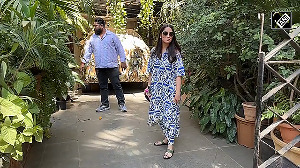From a choice-starved consumer of financial products, India is fast moving to a situation of consumer 'hyperchoice', a situation of multiple options in each product sub-category. We may soon resemble the average American who buys decaf iced vanilla lattes at Starbucks. But here is the paradox of choice: more is less. It has been tested that greater than six options causes buyer paralysis, resulting in confused shoppers turning away.
Something similar is happening in the financial products space in India. So, if you have been worried about finding the 'best' fund, or the most rewarding insurance policy, we have help at hand. Cut out the noise and the frills and choose the most basic product in each category.
The cherry on the cake: lower costs. We bring you four products in the financial space that are no-brainers. Buy it and forget it.
Insurance
Life insurance buyers in India are of two kinds: those who are sold these products, and those who seek out an agent to buy a policy. Though data does not exist on this, but chats with insurance brokers and top agents shows that the products the two buy are different.
Those that are sold a policy buy the flavour of the year - it used to be money-back, then endowment and now unit-linked polices. Those that buy themselves, choose a term life cover. Term insurance is a no-frills policy, which covers only the risk associated with the policyholder and does not give any money back if the policyholder survives the policy term.
The discerning customer understands that a life cover is meant to protect the family's financial health in case of the breadwinner's untimely death. This means a cover of at least seven to 10 times the annual income is a must.
Try doing that in an endowment plan or an Ulip and the premium would become prohibitive - a Rs 30 lakh (Rs 3 million) cover (for a 30-year-old for 30 years) costs Rs 89,160 in annual premium in an endowment and Rs 75,000 a year in a unit-linked policy. A term plan for the same amount costs Rs 9,990 a year.
You get the biggest bang for the rupee from a term plan and 32-year-old IT consultant Satish Arora understands that. He's taken a Rs 50-lakh (Rs 5 million) term cover from HDFC Standard Life Insurance and pays Rs 14,500 as annual premium. Says Arora: "I can manage my finances better by investing in mutual funds. Plus, there is no commitment to pay Rs 250,000 of premium each year."
Exchange traded funds
There is money to be made from a no-brainer option in equity mutual funds. Enter Exchange-Traded Funds. These are close cousins of index MFs that invest in a basket of securities in the same proportion as they lie in the underlying index. Like index funds, ETFs track the market and aim to mirror market returns.
And long-term markets go up. The Sensex has returned 19.09 compounded annual growth rate between April 1979 and January 2007. Reason: only the best companies get included in the index. Non-performers get thrown out and sunrise sectors get included.
In fact, in mature markets like the US, it has been proved that an indexation approach delivers better returns than managed funds over a longer period of time.
So what makes ETF a no-frills vehicle?
Low cost. Sebi rules allow equity funds to charge 2.5 per cent of their assets as expenses and this comes out of your asset value. Index funds cost less as they charge 1.6 per cent on an average.
Reason: an index fund is a no-brainer and, therefore, does not need the fund manager's skills. It is passively managed, as it invests its entire corpus in scrips that lie in the benchmark index in exactly the same proportion. So if an index funds benchmarks itself against, say, the 50-share Nifty index, it, too, will invest its entire corpus in those 50 scrips in the same proportion as they lie in the Nifty.
Here's where an ETF scores. While ETFs charge 0.30 per cent as management fees, they charge 0.63 per cent as total fees, on an average. Investors like businessman Rajendra Patel, 40, fancy the low cost.
"The concept of ETF makes sense. I invest in other MFs also, but highly-paid fund managers do not always beat the market. ETFs match the market for a fraction of cost, so what's wrong in investing in it?" he asks. Out of his investments in mutual funds, Patel invests 5 per cent in these funds right now.
Low tracking error. Typically, index funds aim to mirror market returns. But there's always a small difference between the returns of an index fund and its benchmark index, called tracking error. The lower the tracking error, the better is your index fund.
An acceptable tracking error in India is around 2 per cent. Expenses and your scheme's cash holdings are the biggest cause of tracking error. Due to lower expenses, ETFs have a lower tracking error (0.4 on an average) than index funds (2.5 on an average).
Public provident fund
To get a grip on the principal principle, a no-frills public provident fund is worth a dekko. For one, it scores high on safety since your principal amount invested carries the Government of India badge of honour.
Two, with Big Brother watching, your investment in a PPF also qualifies for tax breaks under Section 80C of the Income Tax Act. What's more, even the interest earned (8 per cent compounded annually) is free from income tax, making it the first among equals for debt-based products.
A similar product will have to earn 11.5 per cent at the 30.6 per cent tax rate to be equal to the return that the PPF gives. And there is yet more to come: there is no cost to entry, maintenance or exit on this product.
You can either open a PPF account at any branch of the State Bank of India and its subsidiaries, a few branches of the other nationalised banks, and all head post offices in the country. Once you open an account, do keep count - your investment is restricted to a Rs 500-70,000 band in a single financial year.
And you can jolly well chip in to this account for 15 years. Unlike in a bank recurring deposit or insurance premiums, you do not need to deposit the same amount every month or year. Hassle-free investment every year would keep the doctor away.
Before maturity, you can make withdrawals from your account starting the sixth financial year. You may even apply for a loan from the third year on.
Compared with debt funds and fixed deposits, PPF gives the biggest bang for the buck. Axe that tax, make PPF sound more like a perennial profit fund! Amen!
Basic homes
When you buy a house, just pause. Now cut that swimming pool and jacuzzi off your social whirl. Mr Rathi next-door won't mind if you snip that super area (carpet area plus swimming pool, club, garden, jogging track, gym and the works). Probably he would if you had entertained him in any space under 1,200 sq. ft. And that's when it starts hurting.
While opulent housing has its own share of demand rationale, a no-frills house does guarantee peace of mind. Here's the sub-text. You can save a minimum of Rs 150,000 by choosing a standard washroom over a premium one replete with fancy fixtures, glass shower cabinets and other accessories.
For a modular kitchen, you need to dish out Rs 125,000-11 lakh, whereas an equally functional standard kitchen, 8 ft x 10 ft in size, could cost a paltry Rs 70,000. True, a landscaped house with good interiors can warm the cockles of your heart. But with a one-time payment for such offerings, monthly maintenance charges could tot up to anywhere between Rs 1,500 and Rs 7,000. Says Kunal Banerjee, vice-president (marketing), Ansal API, "There's a difference of about 25-30 per cent between a no-frills and a premium house."
Prakash Singh, 34, a senior photographer with an international news agency, opted out of a 'fully loaded' house, and instead, invested in his independent residence at Vasundhara in Ghaziabad with modest interiors.
"I bought this house in 2004 at Rs 25 lakh (Rs 2.5 million) and got it renovated according to my requirement," he points out. Prakash at that juncture drew Rs 12 lakh (Rs 1.2 million) a year, and could well afford a mansion then. But he opted for a residential area where property prices were still in their infancy.
"Frill-free flats are tagged between Rs 15 lakh (Rs 1.5 million) and Rs 25 lakh (Rs 2.5 million), whereas apartments with premium accessories cost over Rs 50 lakh," says Banerjee. The difference is stark. Swimming pool? Go drown yourself!





 © 2025
© 2025